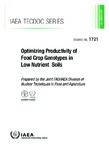Use este identificador para citar ou linkar para este item:
http://www.alice.cnptia.embrapa.br/alice/handle/doc/979291| Título: | Phosphorus use efficiency by brazilian upland rice genotypes evaluated by the 32P dilution technique. |
| Autoria: | FRANZINI, V. I.  MENDES, F. L.   MURAOKA, T.   SILVA, E. C. da   ADU-GYAMFI, J. J.   |
| Afiliação: | VINICIUS IDE FRANZINI, CPATU; CPATU; T. MURAOKA, USP; E.C. DA SILVA, USP; J.J. ADU-GYAMFI, International Atomic Energy Agency. |
| Ano de publicação: | 2013 |
| Referência: | In: OPTIMIZING productivity of food crop genotypes in low nutrient soils. Vienna: FAO: IAEA, 2013. |
| Páginas: | p. 79-92. |
| Conteúdo: | The objectives of this work were to identify the most efficient upland rice genotypes in phosphorus (P) utilization, and to verify if P from the seed affects the classification of upland rice genotypes on P uptake efficiency. The experiment was conducted in a greenhouse of the Center for Nuclear Energy in Agriculture (CENA/USP), Piracicaba, São Paulo, Brazil, using the 32P isotope technique, and plants were grown in pots with samples of dystrophic Typic Haplustox (Oxisol). The experimental design was completely randomized with four replications. The treatments consisted of 47 upland rice genotypes and two standard plant species, efficient or inefficient in P uptake. The results were assessed through correlation and cluster analysis (multivariate). The Carisma upland rice genotype was the most efficient in P uptake, and Caripuna was the most efficient on P utilization. The P derived from seed does not influence the identification of upland rice genotypes in P uptake efficiency. |
| Thesagro: | Arroz Fósforo |
| Série: | (IAEA Tecdoc, 1721). |
| Tipo do material: | Parte de livro |
| Acesso: | openAccess |
| Aparece nas coleções: | Capítulo em livro científico (CPATU)  |
Arquivos associados a este item:
| Arquivo | Descrição | Tamanho | Formato | |
|---|---|---|---|---|
| p79.pdf | 292.92 kB | Adobe PDF |  Visualizar/Abrir |









